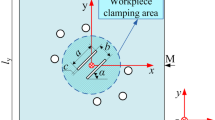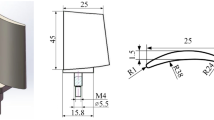Abstract
The transverse vibration of bandsaw blade in the sawing process is a well-known cause of material loss, bandsaw wear, and poor surface quality of workpiece. Five types of surface textures with inverted triangle structure on blade of bandsaw were developed to study their influences on the transverse vibration for sawing. These surface textures with the same total area were designed to identical size with different depths and identical depth with multiple sizes, respectively. The experiments on sawing 45# steels showed that the surface textured bandsaw could reduce the root mean square error (RMSE) of the lateral force by 38.22~48.42% in time domain. Compared with the non-textured bandsaw, the reduction occurred between 300 and 400 Hz in frequency domain. It was probably due to the different effects of dynamic pressure produced by cutting fluids in surface texture. In addition, the textures with the depth to diameter ratio δ = 0.01 showed the best result in this study.
Similar content being viewed by others
References
Sarwar M, Persson M, Hellbergh H, Haider J (2009) Measurement of specific cutting energy for evaluating the efficiency of band sawing different workpiece materials. Int J Mach Tool Manu 49:12–13
Sarwar M, Haider J (2010) Aspects of burr formation in bandsaw teeth manufactured by milling operation. Robot Comput Integr Manuf 26:596–601
Gendraud P, Roux JC, Bergheau JM (2003) Vibrations and stress in band saws a review of literature for application to the case of aluminum-cutting high-speed band saws. J Mater Process Tech. 135(1):109–116
Ni J, Wang HL, Liu XQ, Gu ZH (2014) Active vibration suppression of band sawing system based on main vibration mode prediction. Journal of Mechanical & Electrical Engineering 31(4):12–13
Okai R (2009) Influence of vibration coupling between band saw frame and feed-carriage system on sawdust spillage and surface quality of workpiece during sawing. Eur J Wood Prod 67:189–195
Pohl M, Rose M (2013) Piezoelectric shunt damping of a circular saw blade with autonomous power supply for noise and vibration reduction. J Sound Vib 361:20–31
Wang Z, Jiang XS (2010) Travelling wave mechanism and dynamic mechanical characteristics of band saw blade vibration. Scientia Slivae Sinicae 46(11):119–123
Bai SW, Zhang JS, Wang CH, Wang Z, Huang B, Cheng P (2015) Analytical model of transverse vibration of thin type circulai saw in sawing hard and brittle stone. Trans Chin Soc Agric. (2):372–378
Potocnik P, Thaler T, Govekar E (2013) Multisensory chatter detection in band sawing. Procedia CIRP 8:469–474
Thaler T, Potocnik P, Kopae J, Govekar E (2014) Experimental chatter characterization in metal band sawing. Stroj Vestn-J Mech E 60(4):265–273
Thaler T, Krese B, Govekar E (2015) Stability diagrams and chatter avoidance in horizontal band sawing. CIRP Ann-Manuf Techn 64(1):81–84
Kummel J, Braun D, Gibmeier J, Schneider J, Greiner C, Schulze V, Wanner A (2015) Study on micro texturing of uncoated cemented carbide cutting tools for wear improvement and built-up edge stabilisation. J Mater Process Tech 215:62–70
Lian YS, Deng JX, Yan GY, Cheng HW, Zhao J (2013) Preparation of tungsten disulfide (WS2) soft-coated nano-textured self-lubricating tool and its cutting performance. Int J Adv Manuf Technol 68(9–12):2033–2042
Ibatan T, Uddin MS, Chowdhury MAK (2015) Recent development on surface texturing in enhancing tribological performance of bearing sliders. Surf Coat Tech 272:102–120
Vladescua SC, Olvera AV, Peggb IG, Reddyhoffa T (2016) Combined friction and wear reduction in a reciprocating contact through laser surface texturing. Wear 358-359:51–61
Vladescua SC, Olvera AV, Peggb IG, Reddyhoffa T (2015) Finite element modeling of hard turning process via a micro-textured tool. Int J Adv Manuf Technol 78(9–12):1393–1405
Obikawa T, Kamio A, Takaoka H, Osada A (2011) Micro-texture at the coated tool face for high performance cutting. Int Mach Tool Manu 51(12):966–972
Arulkirubakaran D, Senthikumar V, Kumawat V (2016) Effect of micro-textured tools on machining of Ti-6AL-4V alloy: an experimental and numerical approach. Int J Refract Met H 54:165–177
Zhang KD, Deng JX, Xing YQ, Li SP, Gao HH (2015) Effect of microscale texture on cutting performance of WC/Co-based TiAlN coated tools under different lubrication conditions. Appl Surf Sci 326:107–188
Shen XH, Tao GC (2015) Tribological behaviors of two micro textured surfaces generated by vibrating milling under boundary lubricated sliding. Int J Adv Manuf Technol 79(9–12):1995–2002
Yu HW (2015) Optimal design of surface texture based on hydrodynamic lubrication. Nanjing University of Aeronautics and Astronautics, Nanjing
Sugihara T, Enomoto (2013) Crater and flank wear resistance of cutting tools having micro textured surfaces. Precis Eng 37(4):888–896
Tang W, Zhou YK, Zhu H, Yang HF (2013) The effect of surface texturing on reducing the friction and wear of steel under lubricated sliding contact. Appl Surf Sci 273:199–204
Costa HL, Hutchings IM (2007) Hydrodynamic lubrication of textured steel surfaces under reciprocating sliding conditions. Tribol Int 40(8):1227–1238
Vlădescu SC, Medina S, Olver AV, Pegg IG, Reddyhoff T (2016) Lubricant film thickness and friction force measurements in a laser surface textured reciprocating line contact simulating the piston ring-liner pairing. Tribol Int 98:317–329
Vlădescu SC, Olver AV, Pegg IG, Reddyhoff T (2015) The effects of surface texture in reciprocating contacts—an experimental study. Tribol Int 82(part A):28–42
Gachot C, Rosenkranz A, Hsu SM, Costa HL (2016) A critical assessment of surface texturing for friction and wear improvement. Wear 372-373:21–41
Lu P, Wood R, Gee M, Wang L, Pfleging W (2016) The friction reducing effect of square-shaped surface textures under lubricated line-contacts—an experimental study. Lubricants 4(3):26
Vlădescu SC, Medina S, Olver AV, Pegg IG, Reddyhoff T (2016) The transient friction response of a laser-textured, reciprocating contact to the entrainment of individual pockets. Tribol Lett 62(2):19
Yu HW, Huang W, Wang XL (2013) Dimple patterns design for different circumstances. Lubr Sci 25(2):67–78
Yu HW, Wang XL, Zhou F (2010) Geometric shape effects of surface texture on the generation of hydrodynamic pressure between conformal contacting surface. Tribol Lett 37:123–130
Tae JK, Hee SK (1999) Mechanistic cutting force model in band sawing. Int J Mach Tools Manu 39:1185–1197
Author information
Authors and Affiliations
Corresponding author
Rights and permissions
About this article
Cite this article
Ni, J., Lang, J. & Wu, C. Effect of surface texture on the transverse vibration for sawing. Int J Adv Manuf Technol 92, 4543–4551 (2017). https://doi.org/10.1007/s00170-017-0486-8
Received:
Accepted:
Published:
Issue Date:
DOI: https://doi.org/10.1007/s00170-017-0486-8




